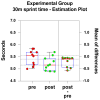Impact of Sled-Integrated Resisted Sprint Training on Sprint and Vertical Jump Performance in Young U-14 Male Football Players
- PMID: 39728240
- PMCID: PMC11678593
- DOI: 10.3390/jfmk9040256
Impact of Sled-Integrated Resisted Sprint Training on Sprint and Vertical Jump Performance in Young U-14 Male Football Players
Abstract
Background/Objectives: The aim of this study was to investigate the effects of a six-week integrated resisted sprint training (IRST) program on sprint performance and vertical jump height in a sample of U-14 male football players. This study also explored the potential benefits of incorporating variable resistive loads during pre-peak height velocity (pre-PHV) developmental stages, a period often overlooked in the training of young athletes. The IRST program alternated between heavy and light resistive sled loads to enhance sprint and jump capabilities, which are critical components of athletic performance in football. Methods: Nineteen healthy male football players (age: 13 ± 0.63 years) were divided into an experimental group (E, n = 10) and a control group (C, n = 9). The experimental group followed the IRST protocol, involving sled sprints with varying resistive loads (10-115% of the body mass) over specific distances, while the control group engaged in traditional unresisted sprint training. The sprint performance was assessed using 30 m sprint times, and the vertical jump height was measured using countermovement jump (CMJ) data collected via a force platform. Anthropometric measures and peak height velocity (aPHV) estimates were also recorded pre- and post-intervention. Results: The experimental group demonstrated significant improvements in 30 m sprint times (mean difference: -0.29 s; p < 0.01). Additionally, CMJ data revealed a positive trend in the take-off velocity and maximum concentric power, with an increase in jump height (mean difference: +0.44 cm). These results suggest enhanced sprint and explosive power capabilities following the IRST intervention. Conclusions: The findings suggest that the IRST program is an effective training method for enhancing sprint performance and maintaining jump capabilities in young football players. This approach highlights the importance of integrating variable resistance training in pre-PHV athletes to promote athletic development while ensuring safety and effectiveness.
Keywords: boys; combined training; countermovement jump; explosive performance; jump capabilities; power; resistance training; sprint training; strength training; youth.
Conflict of interest statement
The authors declare no conflicts of interest.
Figures



Similar articles
-
A Randomized Controlled Trial of Unresisted vs. Heavy Resisted Sprint Training Programs: Effects on Strength, Jump, Unresisted and Resisted Sprint Performance in Youth Rugby Union Players.J Hum Kinet. 2025 Jan 31;95:199-214. doi: 10.5114/jhk/200121. eCollection 2025 Jan. J Hum Kinet. 2025. PMID: 39944984 Free PMC article.
-
Relationship Between Mechanical Effectiveness in Sprint Running and Force-Velocity Characteristics of a Countermovement Jump in Australian Rules Football Athletes.J Strength Cond Res. 2022 Mar 1;36(3):e59-e65. doi: 10.1519/JSC.0000000000003583. J Strength Cond Res. 2022. PMID: 32218062
-
The Effects of Sprint vs. Resisted Sled-Based Training; an 8-Week in-Season Randomized Control Intervention in Elite Rugby League Players.Int J Environ Res Public Health. 2021 Sep 1;18(17):9241. doi: 10.3390/ijerph18179241. Int J Environ Res Public Health. 2021. PMID: 34501831 Free PMC article. Clinical Trial.
-
Effects of Vest and Sled Resisted Sprint Training on Sprint Performance in Young Soccer Players: A Systematic Review and Meta-analysis.J Strength Cond Res. 2022 Jul 1;36(7):2023-2034. doi: 10.1519/JSC.0000000000004255. Epub 2022 Apr 29. J Strength Cond Res. 2022. PMID: 35510888
-
The effectiveness of resisted movement training on sprinting and jumping performance.J Strength Cond Res. 2012 Jan;26(1):299-306. doi: 10.1519/JSC.0b013e3182185186. J Strength Cond Res. 2012. PMID: 22158137 Review.
Cited by
-
Single-Bout Strength: Acute Mental Health Responses to Resistance Training in Active Adults.Sports (Basel). 2025 Jul 7;13(7):221. doi: 10.3390/sports13070221. Sports (Basel). 2025. PMID: 40711106 Free PMC article.
References
-
- Ae M. Handbook of Human Motion. Springer International Publishing; Berlin/Heidelberg, Germany: 2017. Sprint Running: Running at Maximum Speed; pp. 1–29.
LinkOut - more resources
Full Text Sources

